Enver Pasha
Ismail Enver Pasha (Ottoman Turkish: اسماعیل انور پاشا; Turkish: İsmail Enver Paşa; 22 November 1881 – 4 August 1922) was an Ottoman military officer and a leader of the 1908 Young Turk Revolution. He became the main leader of the Ottoman Empire in both the Balkan Wars (1912–13) and in World War I (1914–18). In the course of his career he was known by increasingly elevated titles as he rose through military ranks, including Enver Efendi (انور افندي), Enver Bey (انور بك), and finally Enver Pasha, "pasha" being the honorary title Ottoman military officers gained on promotion to the rank of Mirliva (major general).
Ismail Enver | |
|---|---|
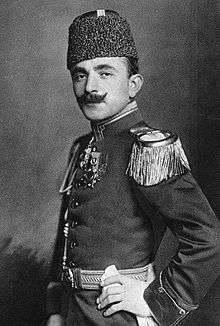 | |
| Minister of War | |
| In office 4 January 1914 – 13 October 1918 | |
| Prime Minister | Said Halim Pasha |
| Preceded by | Ahmet Izzet Pasha |
| Succeeded by | Ahmet Izzet Pasha |
| Personal details | |
| Born | Ismail Enver 22 November 1881 Constantinople (modern day Istanbul), Constantinople Vilayet, Ottoman Empire |
| Died | 4 August 1922 (aged 40) Bukharan People's Soviet Republic, (present-day Tajikistan) |
| Nationality | Ottoman |
| Political party | Committee of Union and Progress |
| Spouse(s) | Naciye Sultan |
| Children | Mahpeyker Hanımsultan Türkan Hanımsultan Sultanzade Ali Bey |
| Alma mater | Army War College (1903)[1] |
| Signature | |
| Military service | |
| Branch/service | Ottoman Army |
| Years of service | 1903–1918 |
| Rank | Mirliva and the de facto Commander-in-Chief |
After the Ottoman coup d’état of January 1913, Enver Pasha became (4 January 1914) the Minister of War of the Ottoman Empire, forming one-third of the triumvirate known as the "Three Pashas" (along with Talaat Pasha and Djemal Pasha) who held de facto rule over the Empire from 1913 until the end of World War I in 1918. As war minister and de facto Commander-in-Chief (despite his role as the de jure Deputy Commander-in-Chief, as the Sultan formally held the title), Enver Pasha was one of the most powerful figures of the government of the Ottoman Empire.[2][3][4] Along with Talaat and Djemal, he was one of the principal perpetrators of the Armenian Genocide,[5][6][7] of the Assyrian Genocide and of the Greek Genocide and thus is held responsible for the death of between 800,000 and 1,800,000[8][9][10][11] Armenians, 300,000 Assyrians and 350,000 Greeks.
Prior to World War I, he was hailed at home as "the hero of the revolution", and Europeans often spoke of Ottoman Turkey as "Enverland".[12]
Early life and career
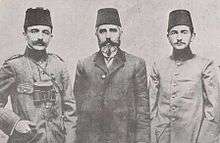
Enver was born in Constantinople (Istanbul) on 22 November 1881. Enver's father, Ahmed (c. 1860–1947), was either a Gagauz Turkish bridge-keeper in Monastir[13] or an Albanian small town public prosecutor in the Balkans.[14] His mother Ayşe Dilara was an Albanian.[15] His uncle was Halil Pasha (later Kut). Enver had two younger brothers, Nuri and Mehmed Kamil, and two younger sisters, Hasene and Mediha. He was the brother in law of Lieutenant Colonel Ömer Nâzım.[16] He studied for different degrees in military schools in the empire and ultimately graduated from the Harp Akademisi with distinction in 1903. He became a major general in 1906. He was sent to the Third Army, which was stationed in Salonica. During his service in the city, he might have become a member of the Committee of Union and Progress (CUP) but this is not assured at all.
Rise to power
Young Turk Revolution
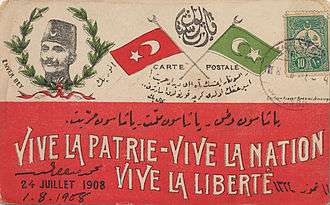
Enver, through the assistance of his uncle Halil Kut became the twelfth member of the Ottoman Freedom Society (OFS) while the organisation was still at an early phase of development.[17] The OFS merged later with the Paris-based group of Ahmed Rıza to create the Committee of Union and Progress (CUP).[17] The CUP gained access to the Ottoman Third Army through Enver.[17] In 1906 upon returning to Monastir (modern Bitola) Enver formed a CUP cell within the town and worked closely with an Ottoman officer Kâzım Karabekir.[17] Enver became the main figure in the CUP Monastir branch and he initiated Ottoman officers like Ahmet Niyazi bey and Eyüp Sabri into the CUP organisation.[18][17]
In the early twentieth century some prominent Young Turk members such as Enver developed a strong interest in the ideas of Gustave Le Bon.[19] For example, Enver saw deputies as mediocre and in reference to Le Bon he thought that as a collective mind they had the potential to become dangerous and be the same as a despotic leader.[20] As the CUP shifted away from the ideas of members who belonged to the old core of the organisation to those of the newer membership, this change assisted individuals like Enver in gaining a larger profile in the Young Turk movement.[21]
In Ohri (modern Ohrid) an armed band called the Special Muslim Organisation (SMO) composed mostly of notables was created in 1907 to protect local Muslims and fight Internal Macedonian Revolutionary Organization (IMRO) bands.[22] Enver along with Sabri recruited the SMO and turned it into the Ohri branch of the CUP with its band becoming the local CUP band.[23] CUP Internal headquarters proposed that Enver go form a CUP band in the countryside.[16] Approving the decision by the committee to assassinate his brother in law Lieutenant Colonel Ömer Nâzım, Enver under instructions from CUP headquarters travelled from Selanik (modern Thessaloniki) to Tikveş on 26 June 1908 to establish a band.[16] CUP headquarters conferred upon Enver the title of "CUP Inspector General of Internal Organisation and Executive Forces".[16]
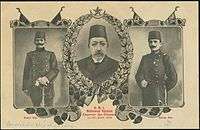
On July 3, 1908 Niyazi protesting the rule of Abdul Hamid II fled with his band from Resne (modern Resen) into the mountains where he initiated the Young Turk Revolution and issued a proclamation that called for the restoration of the constitution of 1876.[25] Following that example Enver in Tikveş and other officers such as Sabri in Ohri also went into the mountains and formed guerilla bands (çetes).[26][25] It is unclear whether the CUP had a fixed date for the revolution; in comments made in an interview following the event Enver stated that they planned for action on August 1908, yet events had forced them to begin the revolution at an earlier time.[27] For the revolt to get local support Enver and Niyazi played on fears of possible foreign intervention.[28] Enver led a band composed of volunteers and deserters.[29] For example, he allowed a deserter who had engaged in brigandage in areas west of the river Vardar to join his band at Tikveș.[23] Throughout the revolution, guerilla bands of both Enver and Niyazi consisted of Muslim (mostly Albanian) paramilitaries.[30]
Enver sent an ultimatum to the Inspector General on 11 July 1908 and demanded that within 48 hours Abdul Hamid II issue a decree for CUP members that had been arrested and sent to Constantinople to be freed.[29] He warned that if the ultimatum was not complied with by the Inspector General, he would refuse to accept any responsibility for future actions.[29] In Tikveș a handwritten appeal was distributed to locals calling for them to either stay neutral or join with him.[29] Enver possessed strong authority among fellow Muslims in the area where he resided and could communicate with them as he spoke both Albanian and Turkish.[31] During the revolution, Enver stayed in the homes of notables, and as a sign of respect they would kiss his hands since he had earlier saved them from an attack by an IMRO band.[32] He stated that the CUP had no support in the countryside apart from a few large landowners with CUP membership that lived in towns, yet they retained influence in their villages and were able to mobilise the population for the cause.[33] Whole settlements were enrolled into the CUP through councils of village elders convened by Enver in Turkish villages of the Tikveş region.[33] As the revolution spread by the third week and more officers deserted the army to join the cause, Enver and Niyazi got like minded officials and civilian notables to send multiple petitions to the Ottoman palace.[34] Enver wrote in his memoirs that while he still was involved in band activity in the days toward the end of the revolution he composed more detailed rules of engagement for use by paramilitary units and bands.[22]
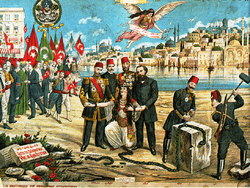
Facing a deteriorating situation in the Balkans on July 24 sultan Abdul Hamid II restored the constitution of 1876.[36] In the aftermath of the revolution Niyazi and Enver remained in the political background due to their youth and junior military ranks with both agreeing that photographs of them would not be distributed to the general public; however, this decision was rarely honoured.[37] Instead Niyazi and Enver as leaders of the revolution elevated their positions into near legendary status, with their images placed on postcards and distributed throughout the Ottoman state.[38][39] Toward the latter part of 1908, photographs of Niyazi and Enver had reached Constantinople and school children of the time played with masks on their faces that depicted the revolutionaries.[40] In other images produced of the time the sultan is presented in the centre flanked by Niyazi and Enver to either side.[24] As the actions of both men carried the appearance of initiating the revolution, Niyazi, an Albanian, and Enver, a Turk, later received popular acclaim as "heroes of freedom" (hürriyet kahramanları) and symbolised Albanian-Turkish cooperation.[41][42]
As a tribute to his role in the Young Turk Revolution that began the Second Constitutional Era of the Ottoman Empire, Niyazi is mentioned along with Enver in the March of the Deputies (Turkish: Mebusan Marşı or Meclis-i Mebusan Marşı), the anthem of the Chamber of Deputies, the lower house of the Ottoman parliament.[43][44] It was performed in 1909 upon the opening of the new parliament.[43][44] The fourth line of the anthem reads "Long live Niyazi, long live Enver" (Turkish: "Yaşasın Niyazi, yaşasın Enver").[44][45] The Ottoman newspaper Volkan, a strong supporter of the constitution published adulatory pieces about Enver and Niyazi in 1909.[46]
Following the revolution Enver rose within the ranks of the Ottoman military and had an important role within army committee relations.[47] By 1909 he was the military attaché at Berlin and formed personal ties with high ranking German state officials and the Kaiser.[47] It was during this time that Enver came to admire the culture of Germany and power of the German military.[47] He invited German officers to reform the Ottoman Army. In 1909 a reactionary conspiracy to organise a countercoup culminated in the "31 March Incident"; the countercoup was put down.[47] Enver for a short time in April 1909 returned to Constantinople and joined the Hareket Ordusu (Army of Action).[47] As such he took an active role in the suppression of the countercoup, which resulted in the overthrow of Abdul Hamid II, who was replaced by his brother Mehmed V, while the power of the CUP was consolidated.[47] Throughout the Young Turk era, Enver was a member of the CUP central committee from 1908 to 1918.[48]
Italo-Turkish War
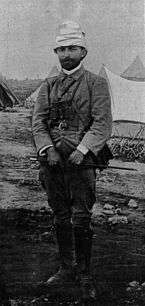
In 1911, Italy launched an invasion of the Ottoman vilayet of Tripolitania (Trablus-i Garb, modern Libya), starting the Italo-Turkish War. Enver decided to join the defense of the province and left Berlin for Libya. There, he assumed the overall command after successfully mobilizing 20,000 troops.[49] Because of the outbreak of the Balkan Wars, however, Enver and other Ottoman generals in Libya were called back to Constantinople. This allowed Italy to take control of Libya. In 1912, thanks to his active role in the war, he was made lieutenant colonel.[50]
However, the loss of Libya cost the CUP in popularity, and it fell from government after rigging the 1912 elections (known as the Sopalı Seçimler, "Election of Clubs"), to be replaced by the Liberal Union party (which was helped by its military arm, the Savior Officers, that denounced the CUP's actions during the 1912 elections). The defeated CUP assumed an ideology favoring more centralization under Enver.
Balkan Wars and seizure of political leadership
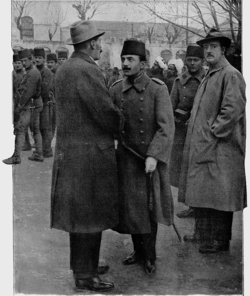
In October 1912, the First Balkan War broke out, and the Ottoman armies suffered severe defeats at the hands of the Balkan League. These military reversals weakened the government, and gave Enver his chance to seize power from the Liberal Union. In a coup in January 1913, he regained power for the CUP and introduced a triumvirate that came to be called the "Three Pashas" (Enver Pasha, Talaat Pasha, and Djemal Pasha). He took the office as Minister of War. Turkey then withdrew from the peace negotiations then under way in London and didn't sign the Treaty of London (1913).
In June 1913, however, the Second Balkan War broke out between the Balkan Allies. Enver Bey took advantage of the situation and led an army into Eastern Thrace, recovering Adrianople from the Bulgarians, who had concentrated their forces against the Serbs and Greeks, with the Treaty of Constantinople (1913). After this success, Enver Bey became a Pasha, and recognised by some Turks as the "conqueror of Edirne".
In 1914, he was again Minister of War in the cabinet of Said Halim Pasha, and married HIH Princess Emine Naciye Sultan (1898–1957), the daughter of Prince Süleyman, thus entering the royal family as a damat ("bridesgroom" to the ruling House of Osman). His power grew steadily while Europe marched towards total war.
World War I
Enver Pasha was an architect of the Ottoman-German Alliance, and expected a quick victory in the war that would benefit the Ottoman Empire. Without informing the other members of the Cabinet, he allowed the two German warships SMS Goeben and SMS Breslau, under the command of German admiral Wilhelm Souchon, to enter the Dardanelles to escape British pursuit; the subsequent "donation" of the ships to the neutral Ottomans worked powerfully in Germany's favor, despite French and Russian diplomacy to keep the Ottoman Empire out of the war. Finally on 29 October, the point of no return was reached when Admiral Souchon, now Commander-in-Chief of the Ottoman navy, took Goeben, Breslau, and a squadron of Ottoman warships into the Black Sea and raided the Russian ports of Odessa, Sevastopol, and Theodosia. Russia declared war on Ottoman Empire on 2 November, and Britain followed suit on 5 November. Most of the Turkish cabinet members and CUP leaders were against such a rushed entry to the war, but Enver Pasha held that it was the right course of action.
As soon as the war started, 31 October 1914, Enver ordered that all men of military age report to army recruiting offices. The offices were unable to handle the vast flood of men, and long delays occurred. This had the effect of ruining the crop harvest for that year.[51]
Minister of War
After taking office in 1913, Enver proved ineffective as War Minister, and frequently over the next four years, the Germans had to support the Ottoman government with generals such as Otto Liman von Sanders, Erich von Falkenhayn, Colmar Freiherr von der Goltz, and Friedrich Freiherr Kress von Kressenstein. The Germans also gave the Ottoman government military supplies and fuel.
Enver Pasha's message to the army and the people was "war until final victory". During the war, living conditions deteriorated rapidly, and discontent grew. Enver would remain War Minister until he fled the country in 1918.
Battle of Sarikamish, 1914
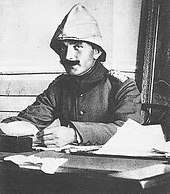
Enver Pasha assumed command of the Ottoman forces arrayed against the Russians in the Caucasus theatre. He wanted to encircle the Russians, force them out of Ottoman territory, and take back Kars and Batumi, which had been ceded after the Russo-Turkish War of 1877–78. Enver thought of himself as a great military leader, while the German military adviser, Liman von Sanders, thought of him as incompetent.[51] Enver ordered a complex attack on the Russians, placed himself in personal control of the Third Army, and was utterly defeated at the Battle of Sarikamish in December 1914 – January 1915. His strategy seemed feasible on paper, but he had ignored external conditions, such as the terrain and the weather. Enver's army (25.000 men) was defeated by the Russian force (100,000 men), and in the subsequent retreat, tens of thousands of Turkish soldiers died. This was the single worst Ottoman defeat of World War I. On his return to Constantinople, Enver Pasha blamed his failure on his Armenian soldiers, although in January 1915, an Armenian named Hovannes had saved his life during a battle by carrying Enver through battle lines on his back.[52] Nonetheless, Ismail Pasha later initiated the deportations and sporadic massacres of Western Armenians, culminating in the Armenian Genocide.[53][54][55][56]
Commanding the forces of the capital, 1915–1918
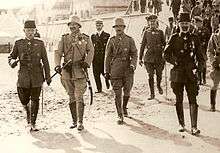
After his defeat at Sarıkamısh, Enver returned to Istanbul (Constantinople) and took command of the Turkish forces around the capital. He was confident that the capital was safe from any Allied attacks.[57] The British and French were planning on forcing the approaches to Constantinople in the hope of knocking the Ottomans out of the war. A large Allied fleet assembled and staged an attack on the Dardanelles on 18 March 1915. The attack (the forerunner to the failed Gallipoli campaign) was a disaster, resulting in the loss of several ships. As a result, Enver turned over command to Liman von Sanders, who led the successful defence of Gallipoli, along with Mustafa Kemal. Enver then left to attend to pressing concerns on the Caucasus Front. Later, after many towns on the peninsula had been destroyed and women and children killed by the Allied bombardment, Enver proposed setting up a concentration camp for the remaining French and British citizens in the empire. Henry Morgenthau, the American ambassador to the Ottoman Empire, convinced Enver not to go through with this plan.[58]
Yildirim
Enver's plan for Falkenhayn’s Yildirim Army Group was to retake Baghdad, recently taken by Maude. This was nearly impossible for logistical reasons. Turkish troops were deserting freely, and when Enver visited Beirut in June 1917, soldiers were forbidden to be stationed along his route for fear that he would be assassinated. Lack of rolling stock meant that troops were often detrained at Damascus and marched south.[59]
Army of Islam
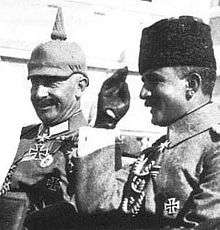
During 1917, due to the Russian Revolution and subsequent Civil War, the Russian army in the Caucasus fell apart and dissolved. At the same time, the Committee of Union and Progress managed to win the friendship of the Bolsheviks with the signing of the Ottoman-Russian friendship treaty (1 January 1918). Enver looked for victory when Russia withdrew from the Caucasus region. When Enver discussed his plans for taking over southern Russia, he ordered the creation of a new military force called the Army of Islam which would have no German officers. Enver's Army of Islam avoided Georgia and marched through Azerbaijan. The Third Army under Vehib Pasha was also moving forward to pre-war borders and towards the First Republic of Armenia, which formed the frontline in the Caucasus. General Tovmas Nazarbekian was the commander on the Caucasus front, and Andranik Ozanian took the command of Armenia within the Ottoman Empire. The Ottoman advance was halted at the Battle of Sardarabad.
The Army of Islam, under the control of Nuri Pasha, moved forward and attacked Australian, New Zealand, British, and Canadian troops led by General Lionel Charles Dunsterville at Baku. General Dunsterville ordered the evacuation of the city on 14 September, after six weeks of occupation, and withdrew to Iran;[60] most of the Armenian population escaped with British forces. The Ottomans and their Azerbaijani allies, after the Battle of Baku, entered the city on 15 September.
However, after the Armistice of Mudros between Great Britain and the Ottoman Empire on 30 October, Ottoman troops were obliged to withdraw and replaced by the Triple Entente. These conquests in the Caucasus counted for very little in the war as a whole but they did however ensure that Baku remained within the boundaries of Azerbaijan while a part of Soviets and later as an independent nation.
Armistice and exile
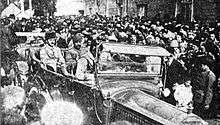
Faced with defeat, the Sultan dismissed Enver from his post as War Minister on 4 October 1918, while the rest of Talaat Pasha's government resigned on 14 October 1918. On 30 October 1918, the Ottoman Empire capitulated by signing the Armistice of Mudros. Two days later, the "Three Pashas" all fled into exile. On 1 January 1919, the new government expelled Enver Pasha from the army. He was tried in absentia in the Turkish Courts-Martial of 1919–20 for crimes of "plunging the country into war without a legitimate reason, forced deportation of Armenians and leaving the country without permission" and condemned to death.[61]
Enver first went to Germany, where he communicated and worked with German Communist figures like Karl Radek. In April 1919, Enver left for Moscow in order to serve as a secret envoy for his friend General Hans von Seeckt who wished for a German-Soviet alliance.[62] In August 1920, Enver sent Seeckt a letter in which he offered on behalf of the Soviet Union the partition of Poland in return for German arms deliveries to Soviet Russia.[62] Besides working for General von Seeckt, Enver envisioned cooperation between the new Soviet Russian government against the British, and went to Moscow. There he was well-received, and established contacts with representatives from Central Asia and other exiled CUP members as the director of the Soviet Government's Asiatic Department.[63] He also met with Bolshevik leaders, including Lenin. He tried to support the Turkish national movement and corresponded with Mustafa Kemal, giving him the guarantee that he did not intend to intervene in the movement in Anatolia. Between 1 and 8 September 1920, he was in Baku for the Congress of the Peoples of the East, representing Libya, Tunisia, Algeria, and Morocco. His appearance was a personal triumph, but the congress failed in its aim to create a mass pro-Bolshevik movement among Moslems. Victor Serge, a witness, recorded that:
At Baku, Enver Pasha put in a sensational appearance. A whole hall full of Orientals broke into shouts, with scimitars and yataghans brandished aloft: 'Death to imperialism" All the same, genuine understanding with the Islamic world...was still difficult.[64]
Relations with Mustafa Kemal
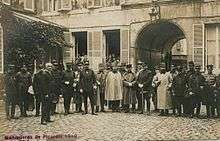
Much has been written about the poor relations between Enver and Mustafa Kemal, two men who played pivotal roles in the Turkish history of the 20th century. Both hailed from the Balkans, and the two served together in North Africa during the wars preceding World War I, Enver being Mustafa Kemal's senior. Enver disliked Mustafa Kemal for his circumspect attitude toward the political agenda pursued by his Committee of Union and Progress, and regarded him as a serious rival.[65] Mustafa Kemal (later known as Atatürk) considered Enver to be a dangerous figure who might lead the country to ruin;[66] he criticized Enver and his colleagues for their policies and their involvement of the Ottoman Empire in World War I.[67][68] In the years of upheaval that followed the Armistice of October 1918, when Mustafa Kemal led the Turkish resistance to occupying and invading forces, Enver sought to return from exile, but his attempts to do so and join the military effort were blocked by the Ankara government under Mustafa Kemal.
Pan-Turkism and death, 1921–22
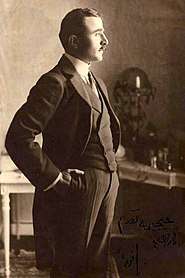
On 30 July 1921, with the Turkish War of Independence in full swing, Enver decided to return to Anatolia. He went to Batum to be close to the new border. However, Mustafa Kemal did not want him among the Turkish revolutionaries. Mustafa Kemal had stopped all friendly ties with Enver Pasha and the CUP as early as 1912,[66] and he explicitly rejected the pan-Turkic ideas and what Mustafa Kemal perceived as Enver Pasha's utopian goals.[65] Enver Pasha changed his plans and traveled to Moscow where he managed to win the trust of the Soviet authorities. In November 1921 he was sent by Lenin to Bukhara in the Turkestan Autonomous Soviet Socialist Republic to help suppress the Basmachi Revolt against the local pro-Moscow Bolshevik regime. Instead, however, he made secret contacts with some of the rebellion's leaders and, along with a small number of followers, defected to the basmachi side. His aim was to unite the numerous basmachi groups under his own command and mount a co-ordinated offensive against the Bolsheviks in order to realise his pan-Turkic dreams. After a number of successful military operations he managed to establish himself as the rebels’ supreme commander, and turned their disorganized forces into a small but well-drilled army. His command structure was built along German lines and his staff included a number of experienced Turkish officers.[69]
From Fromkin 1989, p. 487:
However Enver’s personal weaknesses reasserted themselves. He was a vain, strutting man who loved uniforms, medals and titles. For use in stamping official documents, he ordered a golden seal that described him as ‘Commander-in-Chief of all the Armies of Islam, Son-in-Law of the Caliph and Representative of the Prophet.’ Soon he was calling himself Emir of Turkestan, a practice not conducive to good relations with the Emir whose cause he served. At some point in the first half of 1922, the Emir of Bukhara broke off relations with him, depriving him of troops and much-needed financial support. The Emir of Afghanistan also failed to march to his aid.
On 4 August 1922, as he allowed his troops to celebrate the Kurban Bayramı (Eid al-Adha) holiday while retaining a guard of 30 men at his headquarters near the village of Ab-i-Derya near Dushanbe, the Red Army Bashkir cavalry brigade under the command of ethnic Armenian, Yakov Melkumov (Hakob Melkumian), launched a surprise attack. According to some sources, Enver and some 25 of his men mounted their horses and charged the approaching troops, when Enver was killed by machine-gun fire.[70] In his memoirs, Enver Pasha's aide Yaver Suphi Bey stated that Enver Pasha died of a bullet wound right above his heart during a cavalry charge.[71] Alternatively, according to Melkumov's memoirs, Enver managed to escape on horseback and hid for four days in the village of Chaghan. His hideout was located after a Red Army officer infiltrated the village in disguise. Melkumov's troops then stormed Chaghan, and in the ensuing combat Enver was killed by Melkumov himself.[72][73][74]
From Fromkin 1989, p. 488:
There are several accounts of how Enver died. According to the most persuasive of them, when the Russians attacked he gripped his pocket Koran and, as always, charged straight ahead. Later his decapitated body was found on the field of battle. His Koran was taken from his lifeless fingers and was filed in the archives of the Soviet secret police.
Enver's body was buried near Ab-i-Derya. In 1996, his remains were brought to Turkey and reburied at Abide-i Hürriyet (Monument of Liberty) cemetery in Şişli, Istanbul. Enver's image remains controversial in Turkey, since there are those who blame him for the Ottoman entrance into World War I and the subsequent collapse of the Empire.
Family legacy
Family
After Enver's death, three of his four siblings, Nuri (1889–1949), Mehmed Kamil (1900–62), and Hasene Hanım, adopted the surname "Killigil" after the 1934 Surname Law required all Turkish citizens to adopt a surname.
Enver's sister Hasene Hanım married Nazım Bey. Nazım Bey, an aid-de-camp of Abdul Hamid II, survived an assassination attempt during the 1908 Young Turk Revolution of which his brother-in-law Enver was a leader.[75] With Nazım, Hasene gave birth to Faruk Kenç (1910–2000), who would become a famous Turkish film director and producer.
Enver's other sister, Mediha Hanım (later Mediha Orbay; 1895–1983), married Kâzım Orbay, a prominent Turkish general and politician. On 16 October 1945, their son Haşmet Orbay, Enver's nephew, shot and killed a physician named Neşet Naci Arzan, an event known as the "Ankara murder". At the urging of the Governor of Ankara, Nevzat Tandoğan, Haşmet Orbay's friend Reşit Mercan initially took the blame. After a second trial revealed Haşmet Orbay as the perpetrator, however, he was convicted. The murder became a political scandal in Turkey after the suicide of Tandoğan, the suspicious death of the case's public prosecutor Fahrettin Karaoğlan, and the resignation of Kâzım Orbay from his position as Chief of the General Staff of Turkey after his son's conviction.
Marriage and issue
By his marriage to Naciye Sultan, daughter of Şehzade Selim Suleiman and Ayşe Terziter Hanım, and granddaughter of sultan Abdulmejid I, Enver had:
- HH Princess Dr. Mahpeyker Enver Hanımsultan (1917–2000), married and divorced, Dr. Fikret Ürgüp (1918–?), and had issue, one son:
- Hasan Ürgüp (1948–89) unmarried and without issue
- HH Princess Turkan Enver Hanımsultan (1919–89), married HE Huvayda Mayatepek, Turkish Ambassador to Denmark, and had issue, one son:
- Osman Mayatepek (1950-2016), married Neshe Firtina and had one daughter
- Mihrishah Türkan Mayatepek (b.1992)
- Osman Mayatepek (1950-2016), married Neshe Firtina and had one daughter
- HH Prince Sultanzade Captain Ali Enver Beyefendi (1921 – Australia, December 1971), married and had issue, one daughter:
- Arzu Enver (b. 1955), married Aslan Sadıkoğlu and had Issue
- Burak Sadıkoğlu
- Arzu Enver (b. 1955), married Aslan Sadıkoğlu and had Issue
His widow remarried his brother Mehmed Kamil Killigil (1900–1962) in 1923, and had one daughter:
- HH Princess Rana Killigil Hanımsultan (1926; Paris – 14 April 2008; Istanbul), married Osman Sadi Eldem and had three children:
- Ceyda Eldem (b. 1952)
- Necla Eldem (1954–64)
- Edhem Eldem (b. 1960) married Zeynep Sedef Torunoğlu and had issue, one son:
- Simin Eldem (b.1987)
See also
References
- Komutanlığı, Harp Akademileri (1968), Harp Akademilerinin 120 Yılı (in Turkish), İstanbul, p. 46
- Bourne, J. M. (2001). Who's who in World War One. London: Routledge. p. 282. ISBN 0-415-14179-6. OCLC 46785141.
- Maksudyan, Nazan (25 April 2019). Ottoman children and youth during World War I (First ed.). Syracuse, New York. p. 52. ISBN 978-0-8156-5473-5. OCLC 1088605265.
- New york times current history volume 9. 2012. p. 85. ISBN 978-1-236-26433-6. OCLC 935658756.
- Henham, Ralph; Behrens, Paul, eds. (2009). The Criminal Law of Genocide: International, Comparative and Contextual Aspects. Farnham: Ashgate. ISBN 978-1-40949591-8.
The guilty main architects of the genocide Talaat Pasaha [...] and Enver Pasha...
- Freedman, Jeri (2009). The Armenian Genocide (1st ed.). New York: Rosen Pub. ISBN 978-1-40421825-3.
Enver Pasha, Mehmet Talat, and Ahmed Djemal were the three men who headed the CUP. They ran the Ottoman administration during World War I and planned the Armenian genocide.
- Jones, Adam (2006). Genocide: A Comprehensive Introduction (Repr. ed.). London: Routledge. ISBN 978-0-41535385-4.
The new ruling triumvirate – Minister of Internal Affairs Talat Pasha; Minister of War Enver Pasha; and Minister of Navy Jemal Pasha – quickly established a de facto dictatorship. Under the rubric of the so-called Special Organization of the CUP, they directed, this trio would plan and oversee the Armenian genocide...
- Göçek, Fatma Müge (2015). Denial of violence : Ottoman past, Turkish present and collective violence against the Armenians, 1789–2009. Oxford University Press. p. 1. ISBN 978-0-19-933420-9.
- Auron, Yair (2000). The banality of indifference: Zionism & the Armenian genocide. Transaction. p. 44. ISBN 978-0-7658-0881-3.
- Forsythe, David P. (11 August 2009). Encyclopedia of human rights (Google Books). Oxford University Press. p. 98. ISBN 978-0-19-533402-9.
- Chalk, Frank Robert; Jonassohn, Kurt (10 September 1990). The history and sociology of genocide: analyses and case studies. Institut montréalais des études sur le génocide. Yale University Press. pp. 270–. ISBN 978-0-300-04446-1.
- Asia and the Americas. 18. 1918. p. 923.
- Kaylan, Muammer (2005), The Kemalists: Islamic Revival and the Fate of Secular Turkey, Prometheus Books, p. 75.
- Akmese, Handan Nezir (2005), The Birth of Modern Turkey: The Ottoman Military and the March to WWI, IB Tauris, p. 44.
- Mazower, Mark (2004), Salonica, City of Ghosts: Christians, Muslims and Jews 1430–1950, HarperCollins, p. 255, ISBN 9780375727382.
- Hanioğlu 2001, p. 266.
- Zürcher 2014, p. 35.
- Kansu 1997, p. 90.
- Hanioğlu 2001, pp. 308, 311.
- Hanioğlu 2001, p. 311.
- Hanioğlu 2001, p. 291.
- Hanioğlu 2001, p. 225.
- Hanioğlu 2001, pp. 226.
- Özen, Saadet (2017). "The Heroes of Hürriyet: The images in Struggle". In Lévy-Aksu, Noémi; Georgeon, François (eds.). The Young Turk Revolution and the Ottoman Empire: The Aftermath of 1918. I.B.Tauris. p. 31. ISBN 9781786720214.CS1 maint: ref=harv (link)
- Başkan, Birol (2014). From Religious Empires to Secular States: State Secularization in Turkey, Iran, and Russia. Routledge. p. 51. ISBN 9781317802044.CS1 maint: ref=harv (link)
- Hale 2013, p. 35.
- Hanioğlu 2001, p. 262.
- Gawrych 2006, p. 150.
- Hanioğlu 2001, p. 268.
- Gingeras, Ryan (2014). Heroin, Organized Crime, and the Making of Modern Turkey. Oxford University Press. p. 28. ISBN 9780198716020.CS1 maint: ref=harv (link)
- Hanioğlu 2001, pp. 228, 452. "Enver Bey's mother was from a mixed Albanian-Turkish family, and he could communicate in Albanian."
- Hanioğlu 2001, p. 228.
- Zürcher, Erik Jan (2014). The Young Turk Legacy and Nation Building: From the Ottoman Empire to Atatürk's Turkey. I.B.Tauris. pp. 38–39. ISBN 9780857718075.CS1 maint: ref=harv (link)
- Gingeras 2016, p. 33.
- Bilici 2012, para. 26.
- Hanioğlu 2001, p. 275.
- Hale, William (2013). Turkish Politics and the Military. Routledge. p. 38. ISBN 9781136101403.CS1 maint: ref=harv (link)
- Gingeras, Ryan (2016). Fall of the Sultanate: The Great War and the End of the Ottoman Empire 1908-1922. Oxford University Press. p. 34. ISBN 9780191663581.CS1 maint: ref=harv (link)
- Bilici 2012, para. 25.
- Özen 2017, p. 28.
- Gawrych, George (2006). The Crescent and the Eagle: Ottoman rule, Islam and the Albanians, 1874–1913. London: IB Tauris. pp. 150, 169. ISBN 9781845112875.CS1 maint: ref=harv (link)
- Zürcher, Erik Jan (1984). The Unionist Factor: The Role of the Committee of Union and Progress in the Turkish National Movement 1905-1926. Brill. p. 44. ISBN 9789004072626.CS1 maint: ref=harv (link)
- Güçlü, Yücel (2018). The Armenian Events Of Adana In 1909: Cemal Pasa And Beyond. Rowman & Littlefield. p. 121. ISBN 9780761869948.CS1 maint: ref=harv (link)
- Böke, Pelin; Tınç, Lütfü (2008). Son Osmanlı Meclisi'nin son günleri [The last days of the last Ottoman Assembly]. Doğan Kitap. p. 22. ISBN 9789759918095.CS1 maint: ref=harv (link)
- Bilici, Faruk (2012). "Le révolutionnaire qui alluma la mèche: Ahmed Niyazi Bey de Resne [Niyazi Bey from Resne: The Revolutionary who lit the Fuse]". Cahiers balkaniques. 40.CS1 maint: ref=harv (link) para. 27.
- Vahide, Şükran (2005). Islam in Modern Turkey: An Intellectual Biography of Bediuzzaman Said Nursi. State University of New York Press. p. 69. ISBN 9780791482971.CS1 maint: ref=harv (link)
- Yılmaz, Șuhnaz (2016). "Revisiting Netwrosk and Narratives: Enver Pasha's Pan-Islamic and Pan-Turkic Quest". In Moreau, Odile; Schaar, Stuart (eds.). Subversives and Mavericks in the Muslim Mediterranean: A Subaltern History. University of Texas Press. p. 144. ISBN 9781477310939.CS1 maint: ref=harv (link)
- Hanioğlu, M. Șükrü (2001). Preparation for a Revolution: The Young Turks, 1902-1908. Oxford University Press. p. 216. ISBN 9780199771110.CS1 maint: ref=harv (link)
- Hakyemezoğlu, Serdar, Buhara Cumhuriyeti ve Enver Paşa (in Turkish), Ezberbozanbilgiler, archived from the original on 1 October 2011, retrieved 24 June 2011.
- Enver Paşa Makalesi (in Turkish), Osmanlı Araştırmaları Sitesi.
- Fromkin, David (2001). A Peace to End All Peace: The Fall of the Ottoman Empire and the Creation of the Modern Middle East. New York: H. Holt. pp. 119. ISBN 0-8050-6884-8.
- Derogy, Jacques. Resistance and Revenge, p. 12 Published 1986, Transaction Publishers. ISBN 0-88738-338-6.
- Palmer-Fernandez, Gabriel. Encyclopedia of Religion and War, p. 139. Published 2003, Taylor & Francis. ISBN 0-415-94246-2
- Tucker, Spencer. "World War I", p. 394. Published 2005, ABC-CLIO. ISBN 1-85109-420-2
- Balakian, Peter. The Burning Tigris, p. 184. Published 2003, HarperCollins. ISBN 0-06-019840-0.
- Akcam, Taner. A Shameful Act, p. 143. Published 2006, Henry Holt & Co. ISBN 0-8050-7932-7.
- Moorehead 1997, p. 79.
- Moorehead 1997, p. 166–68.
- Woodward 1998, pp. 160–1.
- Homa Katouzian, State and Society in Iran: The Eclipse of the Qajars and the Emergence of the Pahlavis, (I.B. Tauris, 2006), 141.
- Refuting Genocide, U Mich, archived from the original on 4 April 2002.
- Wheeler-Bennett, John (1967), The Nemesis of Power, London: Macmillan, p. 126.
- Moorehead 1997, p. 300.
- Serge, Victor (1984). emoirs of a Revolutionary. New York: Writer and Readers Publishing Inc. p. 109. ISBN 0-86316-070-0.
- Kaylan, Muammer (8 April 2005). The Kemalists: Islamic Revival and the Fate of Secular Turkey. Prometheus Books. p. 77. ISBN 978-1-61592-897-2.
- Zürcher, Erik Jan (1 January 1984). The Unionist Factor: The Rôle [sic] of the Committee of Union and Progress in the Turkish National Movement, 1905–1926. Brill. p. 59. ISBN 90-04-07262-4.
- Harris, George Sellers; Criss, Bilge (2009). Studies in Atatürk's Turkey: The American Dimension. Brill. p. 85. ISBN 978-90-04-17434-4.
- Rubin, Barry M; Kirişci, Kemal (1 January 2001). Turkey in World Politics: An Emerging Multiregional Power. Lynne Rienner Publishers. p. 168. ISBN 978-1-55587-954-9.
- Hopkirk, Peter (1984), Setting the East Ablaze, London.
- Kandemir, Feridun (1955), Enver Paşa'nın Son Gũnleri (in Turkish), Gũven Yayınevi, pp. 65–69.
- Suphi Bey, Yaver (2007), Enver Paşa'nın Son Günleri (in Turkish), Çatı Kitapları, p. 239, ISBN 978-975-8845-28-6.
- Melkumov, Y, "Interview", Novoe Vremya (in Russian), AM.
- Melkumov, Ya. A. (1960), Туркестанцы [Memoirs] (in Russian), Moscow.
- "Civil War in Central Asia", Ratnik.
- Kedourie, Sylvia (13 September 2013). Seventy-five Years of the Turkish Republic. Taylor & Francis. p. 65. ISBN 978-1-135-26705-6.
Sources
- Fromkin, David (1989), A Peace to End All Peace, Avon Books
- Moorehead, Alan (1997), Gallipoli, Wordsworth Editions, p. 79, ISBN 1-85326-675-2.
- Woodward, David R (1998), Field Marshal Sir William Robertson, Westport, CT & London: Praeger, ISBN 0-275-95422-6.
External links
| Wikimedia Commons has media related to Enver Pasha. |
| Wikiquote has quotations related to: İsmail Enver |
- Enver's biography

- Enver's declaration at the Baku Congress of the Peoples of the East 1920
- Interview with Enver Pasha by Henry Morgenthau – American Ambassador to Constantinople (Istanbul) 1915
- Biography of Enver Pasha at Turkey in the First World War website
- Personal belongings of Enver Pasha
- Ismail Enver Pasha (1881–1922)
- Newspaper clippings about Enver Pasha in the 20th Century Press Archives of the ZBW